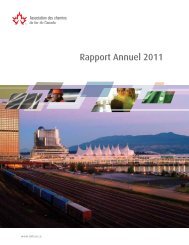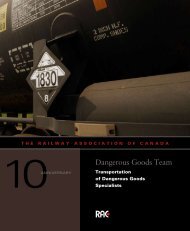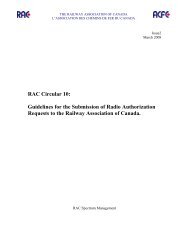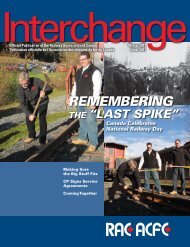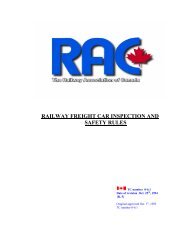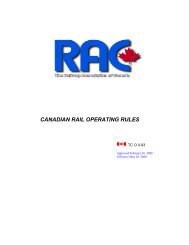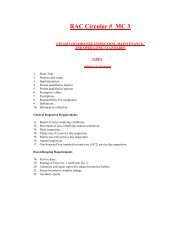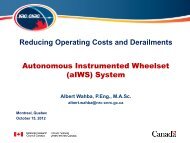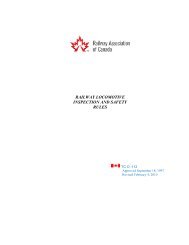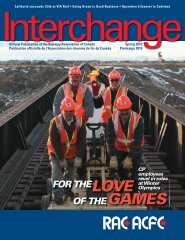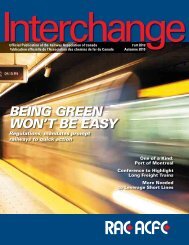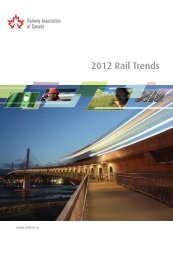Locomotive Emissions Monitoring Program - Railway Association of ...
Locomotive Emissions Monitoring Program - Railway Association of ...
Locomotive Emissions Monitoring Program - Railway Association of ...
You also want an ePaper? Increase the reach of your titles
YUMPU automatically turns print PDFs into web optimized ePapers that Google loves.
Terminology Related to <strong>Locomotive</strong> <strong>Emissions</strong> <strong>Monitoring</strong> and Control<br />
Canada: the Memorandum <strong>of</strong> Understanding (MOU) is a document signed by the <strong>Railway</strong> <strong>Association</strong> <strong>of</strong> Canada,<br />
Environment Canada and Transport Canada which sets out measures on a voluntary basis to address CAC and GHG<br />
emissions from all railway operations in Canada. The MOU calls for a <strong>Locomotive</strong> <strong>Emissions</strong> <strong>Monitoring</strong> (LEM) report to<br />
be published annually containing the respective cumulative data on CAC and GHG emissions, and information related<br />
to emissions reduction actions taken by the railways. The previous MOU covered the period 1995 to 2005; the current<br />
MOU covers the period 2006 to 2010, as exhibited in Appendix A. Once the MOU expires, the voluntary approach will<br />
be replaced with a regulatory regime implemented under the <strong>Railway</strong> Safety Act to take effect in 2011.<br />
U.S.A.: the U.S. Environmental Protection Agency (EPA) rulemaking promulgated in 1998 contains three levels<br />
<strong>of</strong> locomotive-specific emissions limits corresponding to the date <strong>of</strong> a locomotive’s original manufacture, that is,<br />
Tier 0, Tier 1 and Tier 2 (as listed below). The significance <strong>of</strong> the U.S. EPA regulations for Canadian railways is that<br />
the new locomotives they traditionally acquire from the American locomotive original equipment manufacturers<br />
(OEM) are manufactured to meet the latest EPA emissions limits. Hence, emissions in Canada are reduced as these<br />
new locomotives are acquired.<br />
Compliance Schedule for U.S. EPA <strong>Locomotive</strong>-Specific <strong>Emissions</strong> Limits g/bhp-hr<br />
Duty Cycle HC CO NOx PM<br />
Tier 0 ( 1973 - 2001 )<br />
Line-haul 1.0 5.0 9.5 0.60<br />
Switching 2.1 8.0 14.0 0.72<br />
Tier 1 ( 2002 - 2004 )<br />
Line-haul 0.55 2.2 7.4 0.45<br />
Switching 1.2 2.5 11.0 0.54<br />
Tier 2 ( 2005 and later )<br />
Line-haul 0.3 1.5 5.5 0.20<br />
Switching 0.6 2.4 8.1 0.24<br />
Estimated Pre-Regulation (1997) <strong>Locomotive</strong> <strong>Emissions</strong> Rates<br />
Line-haul 0.5 1.5 13.5 0.34<br />
Switching 1.1 2.4 19.8 0.41<br />
Referencing the above-listed limits for locomotives operating in the U.S.A., the EPA in 2008 put into force<br />
revisions which tighten the existing Tier 0 to Tier 2 standards. The revisions are now referred to as Tier 0+, Tier 1+<br />
and Tier 2+ standards. As indicated in the Tables below, they take into account the year <strong>of</strong> original manufacture<br />
<strong>of</strong> the locomotive. Also, two new, more stringent standards levels were introduced, designated Tier 3 and Tier 4.<br />
The revised and new standards are to be phased-in between 2010 and 2015 for locomotives as they become new;<br />
new in this case includes both when locomotives are originally manufactured and when remanufactured. It is<br />
envisaged that to meet the Tier 4 standards, locomotives manufactured starting in 2015 will require additional<br />
exhaust gas treatment technologies to be installed and be dependent upon diesel fuel having a sulphur content<br />
capped at 15 ppm. Elaboration on the U.S. EPA locomotive emissions regulations can be viewed on the website:<br />
www.epa.gov/otaq/locomotv.htm<br />
ix LEM 2008





